
The province of Massa-Carrara is a province in the Tuscany region of Italy. It is named after the provincial capital Massa, and Carrara, the other main town in the province.

Carrara marble, Luna marble to the Romans, is a type of white or blue-grey marble popular for use in sculpture and building decor. It has been quarried since Roman times in the mountains just outside the city of Carrara in the province of Massa and Carrara in the Lunigiana, the northernmost tip of modern-day Tuscany, Italy.

The Duchy of Modena and Reggio was an Italian state created in 1452 located in Northwestern Italy, in the present day region of Emilia-Romagna. It was ruled since its establishment by the noble House of Este, and since 1814 by the Austria-Este branch of the family. The Este dynasty was a great sponsor of the arts, making the Duchy a cultural reference during the Renaissance and Baroque periods.

The Lunigiana or Lunesana is a historical territory of Italy, which today falls within the provinces of Massa Carrara, Tuscany, and La Spezia, Liguria. Its borders derive from the ancient Roman settlement, later the medieval diocese of Luni, which no longer exists.

Pontremoli is a small city, comune former Latin Catholic bishopric in the province of Massa and Carrara, Tuscany region, central Italy.
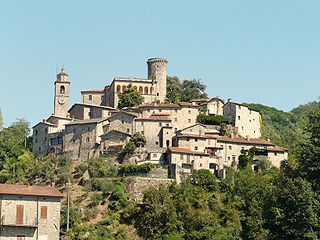
Bagnone is a comune (municipality) in the Province of Massa and Carrara in the Italian region Tuscany, located about 120 kilometres (75 mi) northwest of Florence and about 35 kilometres (22 mi) northwest of Massa in the Lunigiana, facing the Monte Sillara, which has a peak elevation of 1,861 metres (6,106 ft). The Bagnone torrent crosses the Communal territory, a left affluence of the Magra River.

Casola in Lunigiana is a comune (municipality) in the Province of Massa and Carrara in the Italian region Tuscany, located about 100 kilometres (62 mi) northwest of Florence and about 20 kilometres (12 mi) north of Massa.

Fosdinovo is a comune (municipality) in the Province of Massa and Carrara in the Italian region Tuscany, located about 110 kilometres (68 mi) northwest of Florence and about 15 kilometres (9 mi) northwest of Massa.

Mulazzo is a comune (municipality) in the Province of Massa-Carrara in the Italian region Tuscany, located about 120 kilometres (75 mi) northwest of Florence and about 35 kilometres (22 mi) northwest of Massa.
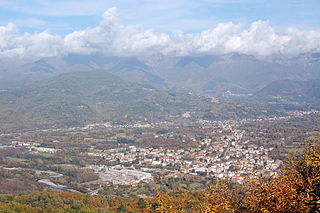
Villafranca in Lunigiana is a comune (municipality) in the Province of Massa and Carrara in the Italian region Tuscany, located about 120 kilometres northwest of Florence and about 35 km (22 mi) northwest of Massa.

Licciana Nardi is a comune (municipality) in the Province of Massa and Carrara in the Italian region Tuscany, located about 110 kilometres (68 mi) northwest of Florence and about 25 kilometres (16 mi) northwest of Massa.
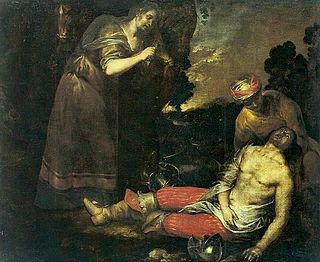
Luciano Borzone was an Italian painter of a late-Mannerist and early-Baroque styles active mainly in his natal city of Genoa.
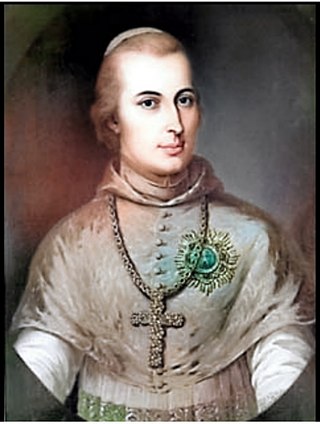
Archduke Karl Ambrosius Joseph Johann Baptist of Austria-Este was an Archbishop of Esztergom.
San Maurizio is the Italian form of Saint Maurice, the Nubian leader of the legendary Roman Theban Legion. He has lent his name to a number of buildings and places in Italy.
Giro della Lunigiana is a four-day road bicycle race for junior men in the historical territory Lunigiana, Italy. The race, class 2.1 MJ on the UCI calendar, counts as a big event in the junior men category. Famous Italian pro riders such as Gilberto Simoni, Danilo Di Luca, Damiano Cunego and Vincenzo Nibali won this race when they were juniors; as did future international stars including grand tour winners Tao Geoghegan Hart, Remco Evenepoel and Tadej Pogačar.
Spinetta Malaspina (1282–1352), also known as Spinetta Malaspina the Great, a descendant of Obizzo Malaspina, was the Marquisse of Verrucola and the lord of Fosdinovo. He is the forefather of the marquisses of Fosdinovo and of its related imperial feud.
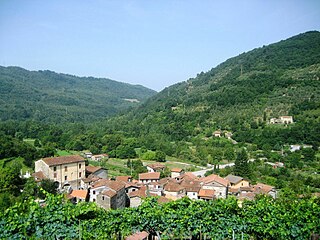
Codiponte is a village in the municipality of Casola in Lunigiana, Tuscany, Italy. It is located in the Province of Massa and Carrara and is about 20 minutes drive from the comune of Aulla. The population is about 200.
The 1920 Garfagnana earthquake occurred on 7 September in Garfagnana and Lunigiana, both agricultural areas in the Italian Tuscany region. The quake hypocenter was located 14 kilometres (8.7 mi) beneath Villa Collemandina. The maximum felt intensity was rated as X (Extreme) on the Mercalli intensity scale, and 6.6 on the Richter magnitude scale. It was one of the most destructive seismic events recorded in the Apenninic region in the twentieth century. Due to good news coverage, availability of official documents on the damage and abundance of recordings from surveillance stations throughout Europe, it was regarded as a first-rate case study to improve knowledge of tectonics and macroseismic analysis.
Carlo Pellegrini (1605–1649) was an Italian painter of the Baroque period.

The House of Malaspina was a noble Italian family of Longobard origin that descended from Boniface I, through the Obertenghi line, that ruled Lunigiana from the 13th to the 14th centuries, and the marquisate of Massa and lordship of Carrara since the 14th century.















